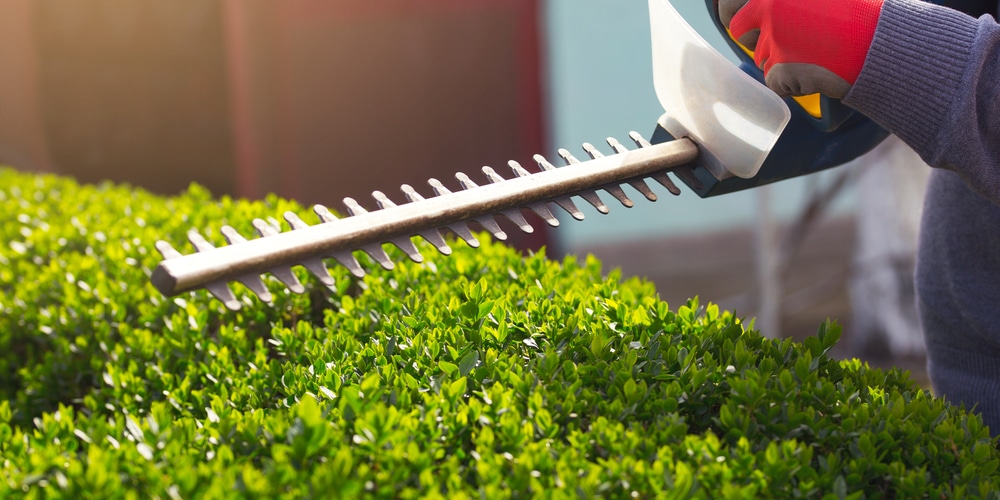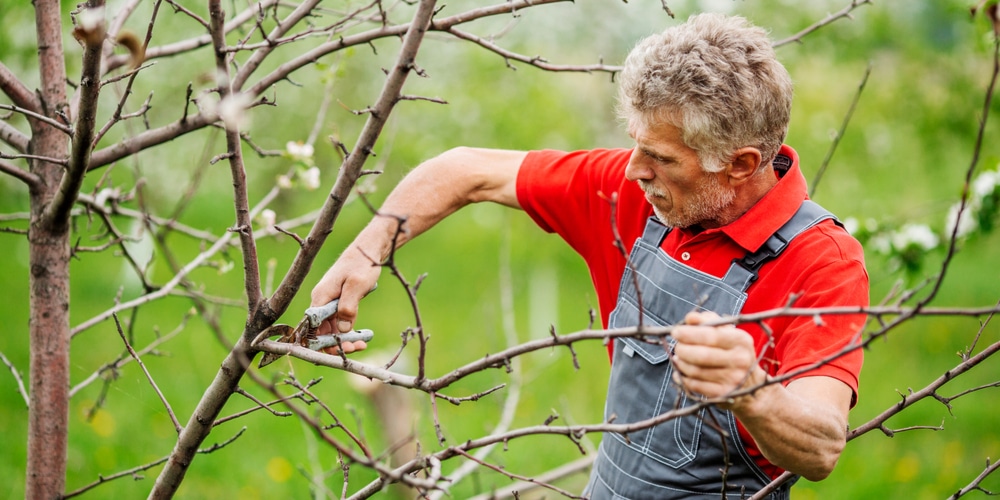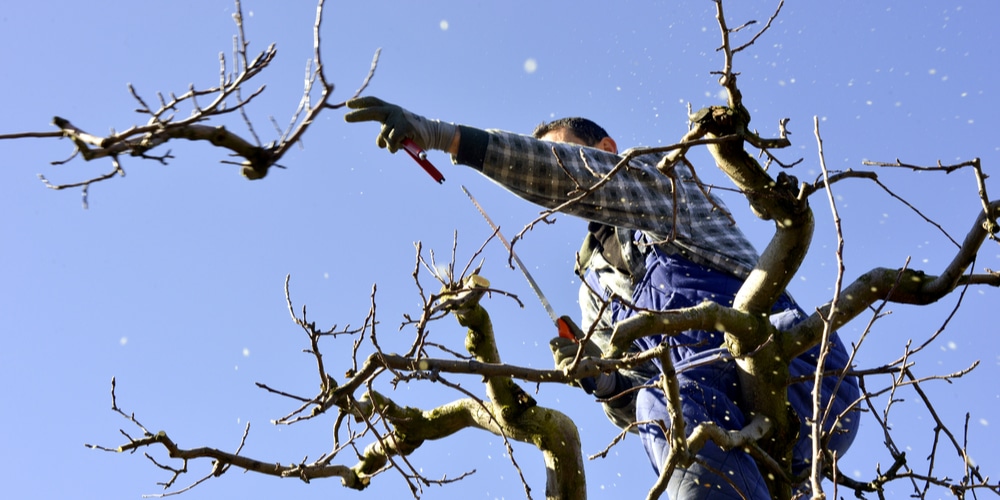Should I Trim My Shrubs and Trees?
- Step 1: Assess the Time of Year
- If it’s late winter or early spring (dormant season), proceed to step 2.
- If it’s late spring or summer (growing season), proceed to step 3.
- If it’s autumn or early winter (approaching dormancy), consider waiting until late winter. Trees and shrubs are entering dormancy, and pruning can interfere with their natural cycle.
- Step 2: Check the Health and Shape of the Shrubs and Trees
- If the trees or shrubs are overgrown, diseased, or damaged, proceed to step 4.
- If they are healthy and well-shaped, no need to trim. Monitor until the next appropriate trimming season.
- Step 3: Identify the Type of Tree or Shrub
- If they bloom in spring, wait until after flowering to trim, then proceed to step 4.
- If they bloom in summer or fall, or are non-flowering, proceed to step 4.
- Step 4: Gather the Right Tools
- Ensure you have clean, sharp tools like pruners, loppers, and saws. Proceed to step 5.
- Step 5: Start Pruning
- Remove dead, damaged, or diseased branches first.
- Thin out areas to increase light and air at the crown of the tree or center of the shrub.
- Trim for shape and size control.
- After pruning, clean up debris and dispose of it properly to prevent the spread of disease.
By following these steps, you can make informed decisions about the best time and method for trimming your shrubs and trees to keep them healthy and looking their best.
Pruning Basics
Pruning is an essential gardening technique that ensures the health and vitality of your trees and shrubs.
Spring is often a great time to give your plants the attention they need.
Let’s get your sleeves rolled up and your garden shears ready for action.
- Why Prune?
- Health: Pruning removes dead or diseased branches to maintain plant health.
- Growth: It encourages new growth and flowering.
- Shape: It helps maintain the plant’s desired shape and size.
- When to Prune
- Prune fruit-bearing trees in early spring for best results.
- Prune flowering shrubs after they bloom to avoid cutting off future flowers.
- How to Prune
- Tools: Ensure you have sharp, clean tools to make precise cuts.
- Technique: Make cuts at a 45-degree angle about 1/4 inch above a bud facing the outside of the plant.
- Limit: Remove no more than one third of the plant each year to prevent stress.
Determining the Right Time to Prune
Choosing the perfect moment to prune your shrubs and trees is crucial for promoting vigorous growth and maintaining their health.
Specific timing can vary by plant species and local climate conditions.
Assessing Plant Dormancy
- Check for Dormant Buds: Ensure that your plants are still dormant before you begin pruning. Dormant buds should be tight and not swollen.
- Examine Sap Flow: Sap flow indicates a plant is exiting dormancy. If you see sap, it might be best to wait until it stops to prune, especially for trees like maples and birch.
Spring Pruning Timetable
- Early Spring: Focus on pruning fruit trees and shrubs before new growth starts. This helps to channel the plant’s energy into producing strong, new growth.
| Plant Type | Pruning Time Frame |
|---|---|
| Fruit Trees | Late winter to early spring |
| Evergreens | Late winter as new growth is still hard |
Tools and Techniques for Effective Pruning
Pruning your shrubs and trees is vital to ensure their health and beauty. This section will guide you through selecting the right tools and employing effective techniques to encourage optimal growth.
Selecting the Proper Tools
To prune effectively, you need the right tools. Here’s what you’ll need for a well-equipped pruning arsenal:
- Hand Pruners: Ideal for cutting branches up to ¾ inch in diameter. Choose from anvil or bypass types based on your comfort and the specific cutting action required.
- Loppers: With long handles, these are perfect for branches that are up to 2 inches in diameter and hard-to-reach areas.
- Pruning Saws: For anything thicker than 2 inches, a pruning saw is your best bet. These come in folding or bow versions.
Remember, always look for tools with comfortable, non-slip grips and ensure they’re sharp for the cleanest cuts.
Pruning Techniques for Optimal Growth
Now that you have your tools, let’s focus on the techniques:
- Identify the Branches: Aim to remove any dead, diseased, or damaged branches first to prevent decay organisms from entering the plant.
- Make the Cut: Cuts should be made just above a bud facing the outside of the plant. This encourages outward growth and prevents crowding.
- Thinning: By selectively cutting branches back to a stem, lateral branch, or a main trunk, you improve light penetration and air flow, which is a boon for health and growth.
- Heading Back: Trim overgrown shrubs by cutting above a lateral bud or branch; this helps control the size and shape of the plant.
Specific Guidelines for Different Plant Types
Spring pruning sets the stage for a season of robust growth and sublime beauty. Your plants have distinct needs, and understanding these requirements is key to their vitality.
Deciduous Shrubs and Trees
- Deciduous Shrubs: These shed their leaves annually and, generally, should be pruned in late winter to early spring.
- Remove dead, damaged, or diseased branches first.
- Thin out the center to allow light and air to reach the interior.
- Prune for shape after the plant’s blooming period if it flowers.
- Cutting back to a strong outward-facing bud promotes outward growth.
- Deciduous Trees: Larger trees might require a professional arborist, but for smaller trees:
- Prune out competing leaders to ensure a single dominant trunk.
- Remove any suckers and water sprouts that take energy from the tree.
Evergreens and Conifers
- Evergreens: They retain their needles or leaves year-round and require minimal pruning.
- Prune for shape during late winter or early spring.
- Snip the tips of the branches to maintain a dense habit.
- Conifers: These cone-bearing trees often need little pruning.
- Remove only diseased or dead branches.
- Limit pruning to the current year’s growth to avoid bare spots as most conifers do not regrow from old wood.
Flowering Shrubs and Fruit Trees
- Flowering Shrubs: The timing of pruning can affect blooming.
- For those that bloom on new wood, prune in late winter or early spring.
- For varieties blooming on old wood, prune just after they flower to avoid cutting off next year’s buds.
- Fruit Trees: Proper pruning enhances fruit production and tree health.
- Prune in late winter to early spring when the tree is still dormant.
- Thin out to allow sunlight to penetrate the canopy and air to circulate, which helps reduce disease occurrence.
Post-Pruning Care and Maintenance
After pruning your shrubs and trees, proper post-pruning care is essential to ensure healthy regrowth and safeguard against diseases. Here’s a streamlined guide to follow:
- Watering:
- Ensure you provide adequate water to the plants, especially if you are heading into a dry spell.
- This helps them recover and grow new shoots.
- Mulching:
- Apply a layer of mulch around the base of your plants to:
-
- Retain soil moisture.
- Regulate soil temperature.
- Minimize weed competition.
- Fertilizing:
- Wait to observe how the plants respond before applying fertilizer.
- If growth appears sluggish, consider a balanced slow-release fertilizer.
- Wound Dressing:
- It’s generally recommended to avoid sealing cuts with wound dressing, as it can trap moisture and create a habitat for diseases.
- Inspection:
- Regularly check the pruned areas for:
-
- Signs of pests.
- Any unusual fungus or rot.
- Careful Handling:
- Handle pruned branches and debris with care to prevent the spread of diseases.
- Clean and sterilize your pruning tools after each use with a solution of one part bleach to nine parts water.
- Support:
- If you’ve pruned a substantial limb, ensure the remaining branches are capable of supporting new growth.
- If not, you may need to provide temporary support.
Frequently Asked Questions
Pruning can boost your garden’s appeal and your plants’ health, but timing and technique are crucial. Knowing when and how to prune ensures shrubs and trees maintain optimal health and vigor.
What is the optimal month for trimming trees and bushes?
For many plants, early spring, just before new growth starts, is the best time for pruning.
For instance, pruning fruit-bearing trees and shrubs early helps to stimulate healthy development before the growing season begins.
How should one prune plants to promote healthy growth?
- Identify and remove dead or diseased branches.
- Cut back to just above a bud facing the outside of a plant to encourage open growth.
- Thin the crown to allow light and air to filter throughout the plant.
Which specific trees benefit from spring pruning?
Trees such as maples, birch, and evergreens like juniper and yew thrive with early spring pruning.
Oak trees are an exception, which should be pruned in winter to prevent oak wilt.
Is there a period when trimming bushes could be harmful?
Avoid pruning when bushes are damp, as this can spread diseases.
Also, do not prune too late in the growing season, as this can stimulate new growth that might not survive winter.
How can pruning too early in the season affect a shrub’s health?
Pruning before the last frost can expose tender new growth to harsh temperatures, resulting in damage or a setback in growth.
Are there any guidelines for pruning flowering shrubs?
- For shrubs that bloom in spring on old wood, prune right after flowers fade.
- For summer-blooming plants that flower on current year’s wood, prune in late winter or early spring.
- Reblooming hydrangeas have less stringent pruning timeframes since they bloom on new and old growth.
Last update on 2024-05-01 / Affiliate links / Images from Amazon Product Advertising API





